#pumpkin in a balanced diet
Text
#pumpkin and immune system#pumpkin antioxidant properties#pumpkin for digestive health#pumpkin recipes for weight loss#pumpkin nutrients and vitamins#pumpkin role in skin health#pumpkin seed oil benefits#pumpkin impact on blood sugar levels#pumpkin anti-inflammatory properties#pumpkin and bone health#pumpkin in a balanced diet#pumpkin role in reducing cholesterol#pumpkin and mental health#pumpkin in natural remedies#pumpkin impact on metabolism
0 notes
Text
um someone needs to tell peter pumpkin eater that a pumpkin is NOT a suitable enclosure for his wife... its nowhere near the minimum size recommended for her species & doesn't accommodate natural behaviours like foraging or needlework. plus humans need to live in sealed hardwall dwellings, that pumpkin will rot eventually which can irritate their delicate respiratory systems.
god why can't people do the bare minimum research before buying a living creature 🙄
#bet he doesn't feed her a complete & balanced diet either... humans are omnivorous & won't thrive on a pumpkin only diet ://#minty post
1 note
·
View note
Text
10 Foods Pregnant Women Should Eat
Eating for two? Make sure to prioritize your health and diet during pregnancy. Check out these 10 nutritious foods for a healthy pregnancy and growing baby! #pregnancy #healthyeating
Pregnancy is a time when a mother-to-be should be mindful of what she eats. As a new mother, you need to prioritize taking care of yourself, your health, and your diet, as everything you consume has an impact on the growing baby inside you. These factors contribute to promoting healthy development in the early stages of pregnancy and preparing your baby for a healthy future. Therefore, if you are…

View On WordPress
#balanced diet#fruits#herbs#iron-rich foods#nutrition#portion control#pumpkin seeds#red chilies#sardines#vegetables#water intake
0 notes
Text
‘that girl’ autumn goals ideas:
hi angels! i feel like as august comes to an end all i want to do is have the coziest, most aesthetic gilmore girls autumn. so here is my autumn ‘that girl’ list, a list of my goals for this season and what i am going to do to feel and look my best as well as having the cutest, most aesthetic autumn. hopefully this inspires you or helps you make your own list of goals.


make an autumn reading list + read every book.
keep a planner.
make cozy autumn playlists to set the mood!
get up by 8am every morning.
meditate + do yoga/stretching.
bake autumn themed goods.
learn how to make autumnal flavoured hot drinks (pumpkin spice etc).
eat the ‘rainbow’ - eat a balanced, healthy diet.
go on autumn walks.
have a halloween themed film night with friends or family.
perfect my autumn wardrobe + make a pinterest inspo board.
make a vision board for the season!
go thrifting or to vintage markets!
journal daily.
make room cozy, get thick blankets, candles and cute pillows.
get some fresh air every day!
find a new cute cafe.
listen to a new motivational podcast.
have a study date with friends!
go to a halloween party.
perfect your autumn workout routine.
switch to warm, comforting breakfasts.
visit a farmers market!
have a spa day!
be creative + make or write something.
visit a book shop/library.
watch autumnal episodes of my favourite tv shows.
treat yourself to new pyjamas/cozy loungewear.
go pumpkin carving!
cut down screen time.


thank you for reading angel! little bit of a shorter post as im planning a few longer ones in the coming week. i hope this has inspired you and been helpful - autumns just about to start pretty much!
love, m.
#becoming that girl#girlhood#clean girl#it girl#girlblogging#glow up#pink pilates princess#it girl energy#just girly things#that girl#autumn#fall aesthetic#fall vibes
1K notes
·
View notes
Text
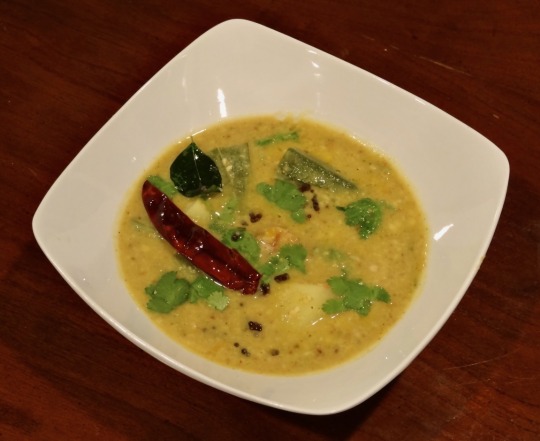
[ID: A bowl of a bright yellow stew topped with cilantro, mustard seed, chili, and curry leaf. End ID]
ಉಡುಪಿ ಸಾಂಬಾರ್ / Udupi sambar
A sambar is a lentil-and-vegetable stew distinguished by the use of a particular spice blend (Hindi: सांबर मसाला "sāmbār masālā," "sambar spice"; Kannada: ಸಾಂಬಾರ್ ಪುಡಿ "sāmbār puḍi," "sambar powder"). Sambars are a staple of South Indian and Sri Lankan cooking, sometimes made in households for multiple meals a week. The word "sambar" can be traced back to the Sanskrit सम्भार "sambhārá," "collection of things required for a particular purpose”; “spices."
The lentil used in sambar dishes is usually tur dal (split pigeon peas), though arhar dal, tuvur dal, or even blends containing masur or mung dal may be used, depending on the cook or the region. Vegetables also vary between combinations of okra, potato, ash gourd (petha), bottle gourd (doodhi / lauki), drumstick (saijan ki phalli), beetroot, tomato, carrot, pumpkin, brinjal, and pearl onions, among others. The sambar masala fries chilis, curry leaves, dal, and various spices including cumin, coriander, and fenugreek, then grinds them into a spicy, earthy, fragrant blend.
This recipe makes a sambar in the style of ಉಡುಪಿ (Udupi) cuisine—a subdivision of the cuisine of the ತುಳುವ (Tuluva) people localised in the Udupi District of Karnataka, a southeastern coastal state of India. (Tuluva cuisine is also commonly found in Dakshina Kannada, Karnataka, and Kasaragod, Kerala). In the Udupi region, sambar may be known as "ಕೊಡೆಲ್" "kodhel"; perhaps related to "ಕಡಲೆ" "kadhale" "Bengal gram"; or "ಹುಲಿ" "huḷi"; "tartness." Udupi huli has coconut oil and jaggery as its primary distinguishing features: the jaggery's deep sweetness and the earthy pungency of unrefined coconut oil combine with the spice of the chilis and the sour fruitiness of the tamarind to create a complex, flavorful, well-balanced dish.
Udupi huli may be further divided into a few major types. ಮಸಾಲೆ ಹುಳಿ ("masāla huḷi") contains shredded coconut and vegetables; ಬೋಳು ಹುಳಿ ("bolu huḷi") contains vegetables, but omits the coconut.
Hotel-style masala huli recipes typically add a lot of jaggery to produce a distinct sweetness; cut back on the amount of coconut included; and contain onion and garlic. The other main type of masala huli—“temple style”—is sattvic (from Sanskrit "सत्त्व" "sattva": "goodness," "essence," "existence"), which in this context means that onions and garlic are excluded.
A sattvic diet in Hinduism centres around the concept of maintaining sattva by eating only pure and mild (sattvic) foods, and omitting tamasic (“dark,” "inert," "destructive"; from Sanskrit तमस् "tamas") and rajasic ("exciting," "passionate," from Sanskrit रजस् "rajas") ones. The concepts of sattva, tamas, and rajas (the गुण "guṇa" system) are central to the construction of caste: the degree to which each person innately inherits each quality supposedly determines their possession of characteristics including honesty, intelligence, and goodness (sattva), stupidity and lack of creativity (tamas), and passion and pridefulness (rajas); the possession of these characteristics in turn determines their rightful place in a professional and social hierarchy. The association of certain foods with certain qualities thus links diet to caste: a distinction in diet is one of the methods by which those belonging to upper castes maintain and police caste boundaries.
This recipe makes enough pudi for one pot of sambar. Traditionally, sambar pudi is created fresh each time the dish is made, but many households make large batches and store them. In this case, omit the coconut; or, use dried coconut and store the masala in the refrigerator.
Recipe under the cut!
Patreon | Paypal | Venmo
Ingredients:
Serves 4-6.
For the sambar:
2 cups chopped vegetables
1 red onion, sliced*
1 cup (200g) yellow split pigeon peas / tur dal / ತೂರ್ ದಾಲ್ (ಹಳದಿ ಸ್ಪ್ಲಿಟ್ ಪಾರಿವಾಳದ ಬಟಾಣಿ)
4 cups (1 litre) water, or as needed
1/4 tsp ground turmeric / haldi / ಅರಿಶಿನ
2 tsp table salt
2 tsp jaggery / gur / ಬೆಲ್ಲ*
1/4 cup (60mL) tamarind pulp (from 1 Tbsp dried tamarind / imlie / ಹುಣಸೆಹಣ್ಣು)
2 tsp unrefined coconut oil / nariyal ka tel / ತೆಂಗಿನ ಎಣ್ಣೆ
Ingredient list format is English / Hindi (Latin transcription) / Kannada. The Hindi is provided for convenience while shopping.
Udupi sambar usually uses any of: gourd, brinjal (Indian eggplant), pumpkin, dumstick (saijan ki phalli), and okra. Pearl onion is not usually used in this region, but you can add whatever you want, according to taste.
*For a hotel-style sambar, include the onion; increase the jaggery to 2 Tbsp.
For the spice paste / sambar masala / ಸಾಂಬಾರ್ ಪುಡಿ ("sambar pudi"):
1/2 Tbsp split Bengal gram / chana dal / ಹಳದಿ ಸ್ಪ್ಲಿಟ್ ಗ್ರಾಂ
2 tsp split black gram / urad dal chilka / ಸ್ಪ್ಲಿಟ್ ಬ್ಲ್ಯಾಕ್ ಗ್ರಾಂ
2 tsp coriander seeds / dhaniya / ಕೊತ್ತಂಬರಿ ಬೀಜದ
1/2 tsp fenugreek seeds / methi / ಮೆಂತ್ಯ
1 tsp cumin seeds / jeera / ಜೀರಿಗೆ
1 tsp ground turmeric
5-6 curry leaves / kari pati / ಕರಿಬೇವು
3-4 Byadagi or other dried red chilis / byadagi mirch / ಬ್ಯಾಡಗಿ ಮೆಣಸಿನಕಾಯಿ
4 cloves garlic, skins on*
Large pinch asafoetida / hing / ಇಂಗು
1 cup (100g) fresh coconut (about one coconut)*
1/2 cup (120mL) water
While the ratio of ingredients in Udupi sambar pudi vary slightly, the ingredients themselves are almost always consistent.
*For a hotel-style sambar, include the garlic, and decrease the coconut in the sambar masala to 1/4 or 1/2 cup (25-50g).
The grams and pulses in this pudi have many different names. You can find them in a halal or South Asian grocery store; look on the bag for the Hindi names (since they have been transcribed into Latin, the spelling may vary from what you see here).
The urad dal you find may be husked, and thus yellow instead of black; these will work just as well.
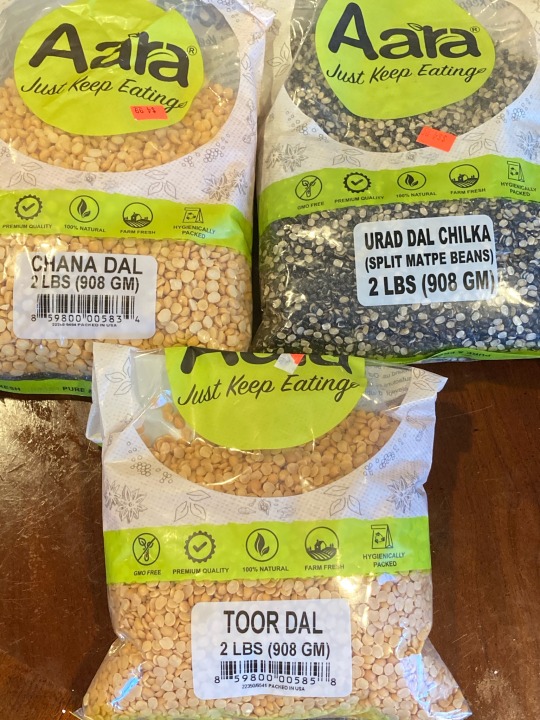
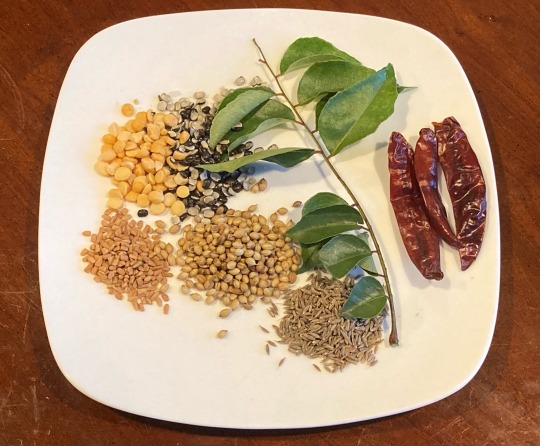
For the tempering / tadka / ಹದಗೊಳಿಸುವ:
2 Tbsp unrefined coconut oil
2 red chilis
8 curry leaves
1 tsp brown mustard seeds / rai / ಸಾಸಿವೆ ಬೀಜಗಳು
Recipes from north Karnataka may add cumin and whole, unpeeled garlic cloves to the tempering.
Instructions:
For the sambar pudi:
1. Break open the coconut and remove and shread its flesh.
If using a whole dried coconut, break into the shell with the wrong side of a hammer and pry open. Break into a few smaller pieces and peel with a vegetable peeler until the skin is removed from the white flesh, wearing something to protect your hand. Soak in warm water for several minutes to soften, and then grate or food process.

2. Heat 2 Tbsp of coconut oil in a skillet on medium-low. Add asafoetida and fry for 30 seconds, until no longer raw-smelling. Add dal and fry, stirring often, for 30 seconds until golden brown; add coriander, mustard, fenugreek, and cumin seeds and fry until fragrant.
3. Add curry leaves and fry until wilted, then add garlic and dried chilis and fry another 30 seconds to a minute, until fragrant.
4. Add coconut and fry, stirring often, for another few minutes until a shade darker. Add turmeric and stir.
5. Grind all ingredients into a paste in a mortar and pestle, then mix in about 1/2 cup water to loosen (if using dried coconut, you may need more water).
Or, put all ingredients along with 1/2 cup water into a blender or food processor and process until a relatively smooth paste forms.
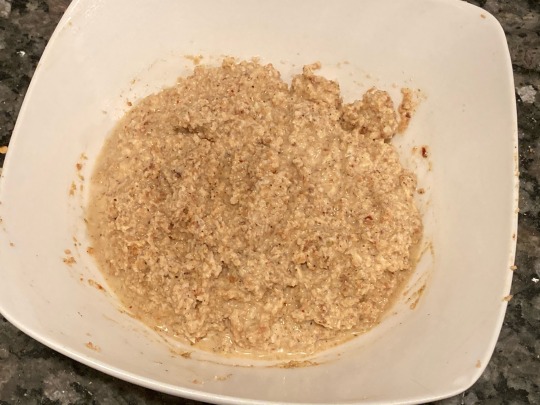
For the sambar:
1. Wash tur dal to remove excess starch. Simmer dal with 2 cups water, 1/4 tsp ground turmeric, and 1 tsp coconut oil for about 30 minutes until very tender. Mash until relatively smooth with a wooden spoon or bean masher, or process briefly with an immersion blender.
You may soak the dal in water after rinsing them to reduce the cooking time, but it is not necessary.
2. Meanwhile, make the tamarind paste. Soak 1 Tbsp tamarind dried pulp in 1/4 cup hot water for 20-30 minutes. Squeeze the tamarind into the water to extract the pulp. Discard the tamarind seeds and husk. Optionally, depending on your preferred texture, push the mixture through a metal sieve.
3. Prepare vegetables. Slice the onion; remove ends of okra and drumsticks and cut into 2-inch pieces; quarter tomatoes; quarter brinjal; peel pumpkin and cut into cubes; peel and cube potatoes.
4. If using onion, add a teaspoon of coconut oil to a large pot and fry until translucent.
5. In the same pot, boil vegetables in just enough water to cover, along with a pinch of salt, until they are beginning to soften.
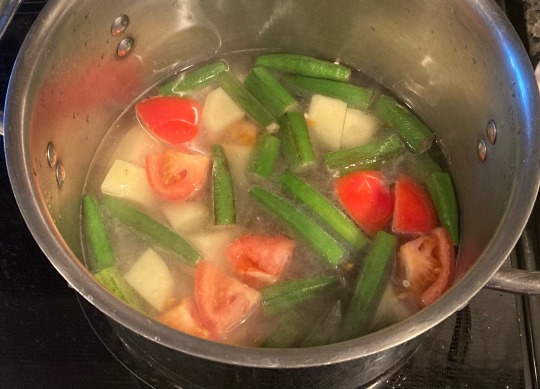
Some recipes call for the vegetables to be boiled, and others call for them to be steamed. I prefer boiling, since it produces a nice savory broth.
6. Mix vegetables, dal, tamarind, jaggery, sambar pudi, and salt to taste and simmer 5-10 minutes to allow flavors to combine and vegetables to cook under tender. Add water as needed. Remove from heat and stir in cilantro. Taste and adjust salt.
The final sambar should be pourable, like a thick soup—Karnataka sambar is typically thinner in consistency than Tamil Nadu versions.
For the tadka:
1. Heat coconut oil in a small skillet on medium heat. Add tempering ingredients and fry, stirring often, until chilis and curry leaves are a couple shades darker and the mixture is fragrant.
2. Pour the oil and tempering ingredients into the sambar and stir in. If you like, retain some of the tadka as a garnish to serve.
3. Serve warm, in individual bowls, alongside long-grain white rice. To eat drumsticks, scoop the center out and eat it; the tough outer rind is left.
If you intend to save some sambar, it's a good idea to make just enough tadka for what you plan to eat that day, and then make fresh tadka to pour over the reheated leftovers.
107 notes
·
View notes
Text

It's September. 15th of this month we, Mexicans, celebrate Independence Day. The whole month, most of the households would prepare traditional food. One of the most delicious and expensive dishes we make is Chiles en Nogada. Mexico has many types of food; the most common is baroque food. Baroque food was created by mixing ingredients brought by colonisers and traditional ingredients. The purpose of Baroque food is to NOT PERCEIVE the ingredients; every bite must generate an explosion of well-balanced flavours in the mouth. This dish is one of those.
Chiles en Nogada is a complex dish; most people would buy it. No, let me correct that; not many people even from here have tasted it because it's expensive af, and the ones who have the means would buy it because it is a pain in the ass to make.
Now, if you want to impress your locals, seduce a Mexican, or challenge your culinary skills this is for you.
The recipe might vary from household to household. This was passed on by my granny, and this is her granny's recipe. SO.
LET'S BEGIN!!
Ingredients!
(I don't care if you don't like x or y, or if you have an allergy or are on a diet, if you can't eat one of these, don't fucking disgrace this legendary recipe.)
150mL of canola oil.
4 finely minced garlic cloves
1 big ass onion finely minced
500g of grounded beef meat
500g of grounded pork meat
2.5 tablespoons of salt
10 red tomatoes
250mL of chicken broth
250g of peeled almonds (preferably minced or sliced, by peeled I mean without the brown cover.)
100g of raisins (finely minced.)
2 Plantanes (NOT BANANA, PLANTANE!)
250g of pine seeds
5 cloves
1 Stick of cinnamon (I used 5cm in length)
1/2 tablespoon of grounded black pepper.
1/2 tablespoon of oregano
Thyme (I don't know how much, in grams this is, be generous.)
2 Minced and peeled peaches
1 Minced pear
1 Minced apple
1 Minced acitrón (I couldn't find it. Acitrón is cristalized maguey. I substituted it with 300g of: Approx 100g of crystallized sweet potato, 100g of crystallized chilacayote, and 100g of crystallized pumpkin).
15 Fresh Poblano Chilipepers (These ARE NOT BELL PEPERS, THESE ARE POBLANO PEPERS, they are spicy.)
1/2 L of milk (cow fresh pasteurized milk, the fresher the better, do not use light milk, we need the fat to mix with the fats of the cheese and the nuts)
250g of goat cheese.
Seeds of 3 pomegranates.
1/2 Kg of peeled fresh Castilian nuts (Juglans regia, the 1/2kg must be nuts without the hardcover).
METODOLOGY!!
Roast, peel, and devein the Chiles. To roast, put them directly on fire until the peel turns black. They are easy to peel when they are hot, so once they are out of the fire, take off the peel (yup, we do this with our bare hands). If you are weak, save the roasted chiles on a cloth and put them inside a plastic bag to "steam." Once cold, you can also peel them; this method works, but it's time-consuming. We also devein the chiles with our hands; if you are weak, use gloves. Please take a moment to appreciate my mom taking off the veins and seeds. She is so talented!


2. Fry the onion in the canola oil until brown. Add the garlic and fry until brown. Add the meat and let it cook on low heat for 20min.
3. Mince the plantains and fry them, use as much oil as you need. Now, I don't care what you believe, the plantains need to have black areas, the blacker the better! They are FINE! I promise. Fry until they look like that:

4. Put water to boil, and let the tomatoes rest/cook? for one minute, then take them out of the boiling water and take off the peel. Put them in the mixer, add the chicken broth, and blend.
5. Add the blended tomatoes and the plantains to the big ass pan where the meat is. This isn't going to look pretty but trust the process!

6. Add the almonds, raisins, pine seeds to the big ass pan.
To show off your wealth and look generous to the people you are sharing this dish with add extra pine seeds.✨

7. Add the oregano, cloves, cinnamon, thyme, pepper, and salt, and mix until all that is well integrated.

Place the thyme, the cloves and the cinnamon on top. We are going to take these out, so make sure you can remove them.
8. Do not cover the pan, let it cook low-heat until it dehydrates. I let this cook for 40min. Once it is dehydrated, remove the cloves, cinnamon, and thyme, add the peaches, the pears, apple, and acitrón (or if you fail getting the acitrón, like I did, use the crystallized fruits).

Mix all that and let it cook low-heat for 20min. This is how it should look like:

9. Now… (🔥laughs) It's time to peel the nuts!! Put water to boil, add the nuts and let them there for ONE minute, take them out of the boiling water and peel that thin dark layer. This is painfully exhausting and BORING, BUT NECESSARY!! You must do it! Otherwhise the final taste will be bitter.


10. NOW, Time to make the Nogada!!! Blend the milk, the nuts, the goat cheese with half a tablespoon of sugar (regular) and salt to taste. The cheese I used had salt, so I didn't use any.
FINALLY, FUCKING FINALLY!! 🔥
11. Fill the cold chiles with that glorious mix we made in our big ass pan, pour some Nogada on top, decorate with pomegranate seeds and parsley. Eat it with rice.
#mexican food#chiles en nogada#recipes#grandmacore#fairy cottage#lmao#I should go to sleep; I'm so tired
8 notes
·
View notes
Text
Health: Misconceptions with Anemia and "Iron Deficiency"
Iron Absorption & Utilization
Simply taking iron supplements often doesn't cure anemia.
Proper absorption and utilization of iron involve many processes.
1/3 of the population has trouble absorbing and utilizing iron; it's considered the most common nutritional disorder in the world.
Anemia is usually about iron dysregulation, not deficiency.
Iron supplements or injections tend to circulate excessively, potentially causing toxicity.
Iron overload strains the iron recycling system and the liver.
Liver plays a key role in regulating iron uptake.
Iron doesn't regulate itself; it's copper-dependent.
Copper is essential for ceruloplasmin, a protein that mobilizes iron from tissues into the blood. Without copper, iron accumulates in tissue leading to inflammation and tissue damage which can develop into others issues like heart or liver disease and diabetes with increased risk of infection and cancer.
Retinol (Vitamin A) enhances iron absorption and influences genes regulating iron metabolism.
Iron Testing
CBC can detect anemia but it can't necessarily tell you the cause.
Serum ferritin doesn't give a true measure of iron stores.
Approximately 70% of iron is found in hemoglobin, around 20-25% is stored as ferritin and hemosiderin in tissues, about 5% is in myoglobin and enzymes, and roughly 0.1% as serum iron.
For accurate assessment, consider all containers of iron including hemoglobin, serum iron, and ferritin, as well as non-iron markers such as zinc, copper, and vitamins A & D.
The only direct way to measure iron stores is to keep removing blood until anemia sets in, then account for the iron deficit and dietary iron consumed during this time.
Sources (meat, liver, and seafood)
Copper: liver, nuts, molasses, oats, bee pollen, shellfish, pumpkin seeds, dark chocolate, acerola cherry powder, shilajit.
Retinol (Vitamin A): liver, other organ meats, egg yolk, seafood, fish liver oils, dairy products.
Other Insights
Phytates in plants can hinder non-heme iron absorption but vitamin C helps to counteract these inhibitory effects.
Over-supplementing with zinc can cause copper deficiency since copper and zinc need to be in balance.
There are many causes of anemia beyond "iron deficiency", such as vitamin B12 deficiency.
The Nobel Prize in Physiology or Medicine was awarded in 1934 to George Whipple, George Minot, and William Murphy for their discoveries related to liver therapy in cases of anemia.
Other studies have supported incorporating beef liver (which contains copper, iron, zinc, vitamin A and D) into the diet.
The key is to have food that isn't concentrated on a certain vitamin or mineral but provides a mixture of what we need in a way that our body can properly absorb without inhibiting effects.
Men are naturally higher in iron than women and women are naturally higher in copper than men (estrogen levels contribute to the production of copper).
Female menstruation is why iron deficiency anemia is more common among women.
Signs of anemia include fatigue, pale complexion, blurred vision, dizziness, irregular heartbeat, cold hands and feet, scanty menstruation, numbness, insomnia, poor memory, dry skin, brittle nails, vertical ridges on nails, muscle twitches, shortness of breath, chest pain, headache, swollen or sore tongue, unusual cravings, restless legs.
48 notes
·
View notes
Text

Minerals are essential nutrients that the body needs for various functions, including building strong bones, transmitting nerve signals, and maintaining a healthy immune system. Here are some food sources of important minerals:
1. Calcium:
Food Sources: Dairy products (such as milk, yogurt, and cheese), leafy green vegetables (such as kale and collard greens), tofu, almonds, and fortified foods (such as fortified plant-based milk).
2. Iron:
Food Sources: Red meat, poultry, fish, beans, lentils, tofu, spinach, quinoa, fortified cereals, and pumpkin seeds.
3. Magnesium:
Food Sources: Nuts (such as almonds and cashews), seeds (such as pumpkin seeds and sunflower seeds), whole grains, leafy green vegetables, legumes, and dark chocolate.
4. Potassium:
Food Sources: Bananas, oranges, potatoes, sweet potatoes, tomatoes, beans, lentils, dairy products, and leafy green vegetables.
5. Zinc:
Food Sources: Oysters, red meat, poultry, beans, nuts, seeds, whole grains, dairy products, and fortified cereals.
6. Sodium:
Food Sources: Table salt, processed foods, canned soups, deli meats, and fast food.
7. Phosphorus:
Food Sources: Dairy products, meat, poultry, fish, nuts, seeds, whole grains, and legumes.
8. Iodine:
Food Sources: Seafood (such as fish and seaweed), dairy products, iodized salt, and fortified foods.
9. Selenium:
Food Sources: Brazil nuts, seafood (such as tuna and shrimp), poultry, eggs, sunflower seeds, and whole grains.
10. Potassium:
Food Sources: Bananas, oranges, potatoes, sweet potatoes, tomatoes, beans, lentils, dairy products, and leafy green vegetables.
It's important to consume a diverse and balanced diet that includes a variety of nutrient-dense foods to ensure you are getting an adequate intake of essential minerals.
#food fight#comfort food#fast food#food for thought#healthy food#food photography#foodie#food#foodpics#foodlover#foodmyheart#japanese food#lunch recipes#pasta recipes#pasta recipe#salad recipes#soup recipe#recipe#reciprocity#recipies#recipes#healthy salad recipes#cozy fall#cozyhome#cozy cozy#cozy autumn#healthy lunch ideas#healthy lunch#healthy diet#healthy
7 notes
·
View notes
Text
What is the Alkaline Diet? A Complete Guide for Beginners
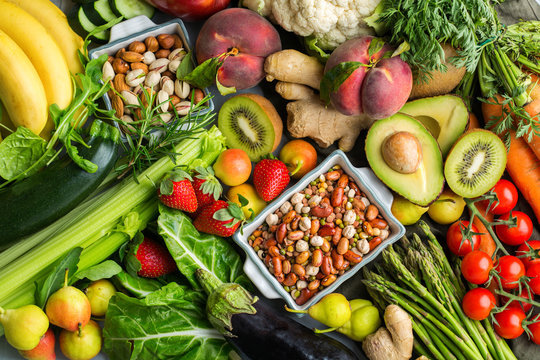
The Alkaline Diet: A Healthy Eating Plan for Optimal Wellness
The alkaline diet has become an increasingly popular way of eating that promotes overall health and wellness. This eating plan focuses on foods that help balance your body's pH levels to create an environment that supports healthy cells and tissues.
What is the Alkaline Diet?
The alkaline diet is based on the principle that the foods you eat can alter your body's pH balance and impact your health. The ultimate goal is to create an internal environment that has a pH ranging from 7.35 to 7.45, which is slightly alkaline.
Foods are categorized as either acidic, alkaline, or neutral:
Alkaline foods - Fruits, nuts, legumes, and vegetables
Acidic foods - Meat, dairy, eggs, grains, alcohol, and processed foods
Neutral foods - Natural fats, starches, and sugars
By emphasizing alkaline foods and limiting acidic foods, proponents of this diet believe it can help neutralize chronic low-grade acidosis linked to inflammation, fatigue, and increased disease risk.
Benefits of an Alkaline Diet
Following an alkaline diet offers impressive benefits:
Promotes pH balance
Reduces inflammation
Boosts immunity
Increases energy
Aids weight loss efforts
Improves cardiovascular health
Strengthens bones
Detoxifies the body
The diet focuses on nutrient-dense whole foods that provide antioxidants, vitamins, minerals, fiber, and water to help neutralize acids and remove toxins from the body.
Balances pH Levels
One of the main goals of the alkaline diet is to balance the body's pH levels. Chronic low-grade acidosis happens when acidic wastes accumulate in the body faster than they can be neutralized. This causes the body's pH to drop into unhealthy ranges.
The alkaline diet counteracts this acidity and helps:
Regulate fluids and electrolytes
Filter out toxins and wastes
Transport nutrients into cells
Together this provides an ideal environment for cells and systems to function properly.
Reduces Inflammation
Acidosis creates an environment inside the body that promotes inflammation, a key factor in many chronic diseases.
The anti-inflammatory foods emphasized on the alkaline diet can help reduce acidity and calm this internal fire. Some examples include:
Fruits high in vitamin C
Green leafy vegetables
Nuts like almonds and walnuts
Plant-based proteins like lentils and beans
Lower levels of inflammation helps people feel better day-to-day. But even more importantly, it lowers the risk for disorders caused by chronic inflammation.
Other Key Benefits
Some other top reasons to follow the alkaline diet include:
Increased Energy Levels - A balanced pH provides cells with ideal conditions for producing energy.
Healthy Weight - The diet emphasizes low energy-density foods that support weight loss.
Strong Bones - The diet provides bone-building nutrients often lacking in modern diets.
Detoxification - Alkaline foods help remove acidic waste products and toxins.
Together this creates an internal terrain that discourages damaged cells and chronic diseases from taking root.
The Best Alkaline Foods to Eat

Focus your diet around these alkaline superfoods:
Fruits
Fruits are packed with alkaline-promoting nutrients. Choose fresh or frozen organic when possible. Top picks include:
Lemons
Watermelon
Apple
Grapefruit
Kiwi
Berries
Papaya
Pears
Vegetables
Aim for eating a variety of organic vegetables each day. Great options include:
Spinach
Kale
Cucumbers
Celery
Carrots
Sweet potatoes
Broccoli
Sea vegetables
Nuts and Seeds
Nuts and seeds are excellent sources of protein and healthy fats. Soak nuts before eating to boost nutrients. Try:
Almonds
Flaxseeds
Pumpkin seeds
Sunflower seeds
Chestnuts
Chia seeds
Herbs, Spices and Oils
Boost flavor and pH with these additions:
Lemongrass
Ginger
Turmeric
Cinnamon
Garlic
Cold-pressed olive oil
Coconut oil
Avocado oil
Foods to Avoid on the Diet

To balance your pH effectively, you’ll also want to avoid or limit these acidic foods:
Red meat
Poultry
Seafood
Eggs
Dairy products
Processed grains
Sugar
Packaged snacks
Soda
Alcohol
Coffee
Even whole grains and beans - two staples of healthy diets - should be eaten sparingly since they skew acidic.
Additional Tips for Success
Follow these suggestions to make the most of an alkaline diet:
Stay well hydrated with alkaline water
Enjoy herbal teas
Reduce stress through yoga, meditation, etc.
Exercise at least 30 minutes daily
Add more raw foods slowly
Focus on how you feel
As with any significant change to your diet, implement this eating pattern gradually. This gives your body time to adjust its complex systems. Pay attention to the signals your body is sending about the changes.
Over time, you should feel less internal "discomfort" and more vibrant energy. Chronic issues you learned to tolerate could show improvement or fade away completely.
The Bottom Line
The emerging research shows an alkaline diet may be an extremely healthy way to prevent damage from modern diets and lifestyles. While studies continue, adjusting your eating pattern to favor alkaline foods poses little risk and offers tremendous potential.
It provides a sustainable, nutrient-dense approach to eating that fights inflammation and encourages good health starting on the inside!
Doctor Sebi Cell Food Diet Explained: Components, Purported Benefits, Controversy & Safety Reviewed
Read the full article
8 notes
·
View notes
Text
Chapter 9 of My Poppy Playtime Longfic is Up!
A few days after he and Theodore had confessed their feelings to one another, Grayson went on his first food run. He primarily bought some non-perishables, but The Prototype had assured that he had some freezer space to stock up on meat.
The plan was to incorporate the meat that Grayson had bought, as well as the meat from the recently butchered Hoppy Hopscotch and KickinChicken, into the other things that Grayson had purchased. The experiments had been running on raw meat for so long, that other food in excess would likely make them sick, so it needed to be a slow process, transferring them to a more balanced diet.
Grayson was put in charge of meal preparation. He used the kitchen in the main cafeteria, the one that the staff had once used for lunch breaks. It was large and well-equipped, with multiple stoves, ovens, and sinks. The walls were a light blue color, and the cabinets were a darker shade of blue. He kind of liked the ambiance.
Grayson was basically making raw dog food at this stage. It had to be similar to what the toys were used to for the time being. The Prototype had assured him that the experiments would be just fine with whatever Grayson made. Most of them did not have a very detailed sense of taste apparently. However, Grayson still wanted to make it as palatable as possible.
He used to cook with his Aunt Molly, so he wasn't a total novice in the kitchen. He started by mixing together the raw beef, which he had cut into small pieces, with some of the other foods he had bought. He added some canned pumpkin, which The Prototype had suggested would help with the toys' digestion, some rice, some cooked celery and eggplant, and some plain yogurt, for a little bit of probiotics. Then he seasoned it with some salt and pepper, as well as a few dried herbs.
Grayson tasted the mixture, making a face. It wasn't exactly appetizing, but he knew that it would adequate enough compared to the experiments eating one another. He placed the prepared food into a large bowl and added some more of the raw meat, as well as some of the cooked vegetables and rice. He mixed everything together thoroughly, making sure that everything was evenly distributed.
He then portioned out the food. Theodore helped with that step, knowing how much each individual needed to be satisfied. They placed the portions into sealed plastic containers and labeled them with the names of the toys they belonged to. Once that was done, Grayson took the containers and went to the lab.
There, they placed the rest of the food for the week into the industrial sized freezer in the main lab. The Prototype assured that the food would be distributed, but suggested that Grayson and Theodore take the food for those in Playcare and hand it out. They agreed.
Read more on AO3
#poppy playtime#poppyplaytime#catnap#the prototype#experiment 1006#theodore grambell#miss delight#huggy wuggy#ao3#fanfic#fan fiction
3 notes
·
View notes
Text
🍁Welcome to Fall/Autumn🍁 | Part 2

We've all heard of seasonal depression, but did you know it is a real medical condition? The Cleveland Clinic states, "Seasonal depression, also called seasonal affective disorder (SAD), is a type of depression. It’s triggered by the change of seasons and most commonly begins in late fall. Symptoms include feelings of sadness, lack of energy, loss of interest in usual activities, oversleeping, and weight gain." Preparing for fall to prevent or alleviate seasonal depression, also known as Seasonal Affective Disorder (SAD), involves proactive steps to maintain your mental and emotional well-being as the days get shorter and the weather becomes colder.
Here are some strategies to help you prepare for fall and mitigate the symptoms of SAD:
Light Therapy: Consider investing in a light therapy box, also known as a lightbox. These devices mimic natural sunlight and can help alleviate the symptoms of SAD. Use the lightbox in the morning for about 20-30 minutes to regulate your circadian rhythm and boost your mood.
Maintain a Regular Schedule: Stick to a consistent daily routine, including regular wake-up and sleep times. This can help regulate your body's internal clock and improve your mood.
Get Outside: Make an effort to spend time outdoors, even on cloudy days. Exposure to natural light, even when it's overcast, can be beneficial. Take short walks during daylight hours or eat lunch outside if possible.
Exercise Regularly: Engaging in regular physical activity has been shown to be effective in combating depression. Find an indoor or outdoor exercise routine that you enjoy, such as yoga, dancing, or jogging.
Healthy Eating: Maintain a balanced diet rich in fruits, vegetables, whole grains, and lean proteins. Consider adding foods high in omega-3 fatty acids, like salmon or flaxseeds, which may have mood-boosting benefits.
Stay Social: Isolation can worsen symptoms of depression. Stay connected with friends and loved ones, even if it means meeting virtually. Plan social activities or join clubs or groups that align with your interests.
Mindfulness and Meditation: Practice mindfulness or meditation techniques to reduce stress and increase self-awareness. Mindfulness can help you stay present and manage negative thought patterns.
Set Realistic Goals: Break your tasks and goals into smaller, manageable steps. Celebrate your achievements along the way to maintain a sense of accomplishment.
Therapy and Support: Consider therapy, such as cognitive-behavioral therapy (CBT), which has been shown to be effective in treating SAD. A therapist can help you develop coping strategies and provide support during difficult times.
Medication: If your symptoms are severe or do not improve with other interventions, consult a healthcare professional about the possibility of medication to manage SAD symptoms.
Plan Fun Activities: Make a list of enjoyable fall activities and events you can look forward to, such as apple picking, pumpkin carving, or attending fall festivals.
Create a Cozy Environment: Make your living space warm and inviting. Decorate with soft blankets, warm colors, and items that make you feel comfortable and cozy.
Monitor Your Mood: Keep a mood journal to track your feelings and identify patterns. This can help you recognize when your symptoms worsen and when you might need extra support.
Stay Informed: Educate yourself about SAD and its symptoms. Knowing what to expect can help you take proactive steps to manage your mental health.
Consult a Healthcare Professional: If you suspect you have SAD or if your symptoms worsen, seek professional help. A healthcare provider can assess your condition and recommend appropriate treatment options.
Remember that everyone's experience with SAD is different, and what works for one person may not work for another. It's important to tailor your self-care and treatment plan to your individual needs. Don't hesitate to reach out for support from healthcare professionals or mental health experts if you're struggling with seasonal depression.
#fall aesthetic#autumn aesthetic#cozy autumn#cozy fall#cozy aesthetic#cozy vibes#spooky aesthetic#spooky season#halloween aesthetic#halloween#pumpkin season#naturecore#spooky#halloween moodboard#fall#autumn#fall moodboard#autumn moodboard#seasonal affective disorder#depression#mental health#mental health awareness#self help
16 notes
·
View notes
Text
Health update
My eczema has recently cleared up when I quit fasting. Some cuts and dead skin on my hands, but my fingers and the backs of my hands are no longer dry! I can bend my fingers and my palms feel so smooth. All it did was to quit fasting.
Now I do get allergic reactions, especially to dogs and pollen. My younger dog likes to sleep on my bed and licks her paws. I know my room is covered in dander at this point. I do get itchy on my face, neck, and hands. But it's not horrible. This is a separate issue from my hormone imbalances due to stress and prolonged fasting.
I'll eventually go back to fasting during week 1 and 3 of my cycle, and reducing the fasting on week 2 and 4. I'm not necessarily going to eat lower carb on week 1 and 3, as long as I'm eating mostly anti-inflammatory it honestly shouldn't matter. In general eating gut and hormone friendly foods and cycling my fasts in a way that will promote weight loss and autophagy, but no hormonal imbalances. I love carbs so I wouldn't go low carb all the way. My body doesn't have a problem with complex carbs. It does with excess sugar and junk carbs, but not things like fruit, whole grains, dark chocolate, or starchy veggies. Going too strict with my diet will definitely backfire.
So I've been balancing my hormones, and I've been eating anti-inflammatory. Of course we want a balance in life, so I'm going to fast cycle, not go low carb, and treat myself here and there so I don't feel deprived. I shared a pizza slice with my mom today. I got some aged cheddar popcorn so I have something to eat before my therapy session. Some "inflammatory" foods here and there won't do any damage. As long as most of my diet is low in refined sugars, white breads, fats, oils and processed meats. I know eating anti-inflammatory helps my skin. Combined with gut and hormone support.
I've been eating more pumpkin seeds which are great for hormones.
I've been looking into ways to support gut health. I've been chewing slowly, drinking aloe juice, eating anti-inflammatory (the best thing you can do for your gut), and eating Greek yogurt for probiotics.
I wanted to support anti-microbial effects so I don't experience any recurring infections like h pylori and staph and strep. I also want to ensure I have enough stomach acid and digestive enzymes. I'm doing an h pylori breath test in a few days and I hope I get a negative result. H pylori is a problem because it reduces stomach acid levels, which prevents proper digestion and allows for more downstream infections to occur (in the small and large intestines) because stomach acid also acts as a sterilizer that kills foreign pathogens. Stomach acid is important and I want to ensure I killed off the h pylori and am producing enough acid and can prevent further infections from occurring in the future.
I also want to ensure I am producing enough digestive enzymes. I know I am tired of taking multiple supplements, but enzymes can be so helpful. I know I prefer food sources, but the foods that are most rich in enzymes are tropical fruit, which I don't like. I do have a digestive enzyme supplement. I've been taking it a month or so ago and took it again today with lunch. I'll ask my doctor about all this when I do my mineral scan later this month. I'll also ask about acid, h pylori, and aloe juice.
I'm so happy because I feel better. Just some minor gut support and fast cycling and I'll be in good hands. I'm also going t get the psychological and psychiatric support I need.
2 notes
·
View notes
Text
SUSTAINABLE FOODS
For a healthy body, a healthy planet, and a healthy future, it's important that we each look carefully at including the most sustainable foods in our diet.
Sprouts
The sprouting process doubles, and in some cases triples, the nutritional value of planet.
Nuts and Seeds
Nuts and seeds are considered to be little power houses of the meal plan. Their protein, vitamin E and good fat content, paired with desirable flavor and texture.
Root vegetables
Root vegetables which are the crisp and colorful underground parts of plants re eaten as these vegetables are rich sources of carbohydrates.
Cereals, pulses and legumes
Cereals and grains are considered as the most important source of food for human consumption rice, maize and wheat and millets are diversified sources of carbohydrates. many of them are readily available while others need to be brought back into the food system with balance diet planned legumes.
Leafy greens
They are the most versatile and nutritious of all types of vegetables. they are grown as part of other vegetables such as beets and pumpkins and as the leaves themselves.
Mushrooms
Research says that there are more than 2,000 edible varieties of mushrooms cultivate for centuries for their taste and nutritional value.
SKIP THE DIET, JUST EAT HEALTHY
Protect the Environment
If you eat seasonal foods, you will reduce co2 emissions
Balance your diet
Choose a diet which in greens, pulses, fruits and vegetables
Join a consumer group
it will give access to local healthy products without intermediaries
Support fair trade
Choose foods that promote a respectful business relationship
ORGANIC FOOD EVERYDAY
->Your daily needs
->Fresh handpicked vegetables everyday
->Savor your most delicious food everyday
->100% natural and fresh
3 notes
·
View notes
Text

Green Leafy Vegetables is what we need to include in our diet for an alkaline effect on our bodies. It is often said that disease cannot take root in a body that has a balanced pH.
⠀⠀
Foods in their raw form are more alkaline than acidic in nature, as they have not been modified by heat. Their enzyme quality has not been compromised.
⠀⠀
Prioritise organic foods when possible, which are grown in a more mineral-dense soil, for greater benefits.
⠀⠀
Alkaline diet benefits may include helping to slow down degeneration of tissues and bone mass, which can be compromised when too much acidity robs us of key minerals.
⠀⠀
Additionally, the benefit of an alkaline diet is that it decreases inflammation and causes an increase in growth hormone production. This implies an anti aging effect as well as a preventative one against diseases such as cancer.
Here are our top alkalising vegetables and fruits: ⠀⠀
-Cucumbers
-Kale -Celery -Alfalfa
-Parsley -Avocado
– Barley grass
– Wheat grass
– Beets
– Beet greens
– Sea vegetables – Capsicum
– Cabbage
– Collards
– Endive
– Garlic
– Ginger
– Green beans
– Lettuce
– Mustard greens
– Okra
– Radish
– Red onion
– Arugula/Rocket
– Artichokes
– Asparagus
– Brussels sprouts
– Cauliflower
– Carrot
– Chives
– Zucchini/Courgette
– Leeks
– New baby potatoes
– Peas
– Rhubarb
– Watercress
– Green peas
– Parsnips
– Pumpkin
– Sweet potatoes
⠀⠀
Alkalizing Fruit
⠀⠀
-Lemons
– Lime
– Grapefruit
– Orange
– Fresh coconut (flesh and water)
– Cantaloupe
– Fresh dates
– Nectarines
– Plums
– Sweet cherries
– Apple
– Apricot
– Avocado
– Banana
– Sour cherries
– Grapes
– Honeydew Melon
– Peach
– Pear
– Pineapple
– Rhubarb
– Tomato
– Strawberries
– Blueberries
– Blackberries
– Cranberries
– Mango
3 notes
·
View notes
Text
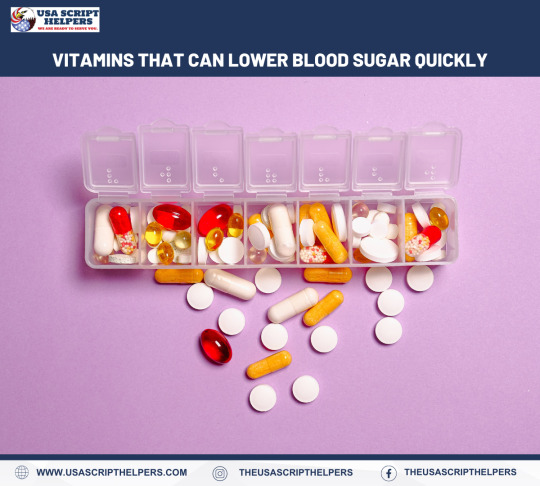
VITAMINS THAT CAN LOWER BLOOD SUGAR QUICKLY
Balancing blood sugar levels is crucial for maintaining overall health, especially for individuals with diabetes or those at risk of developing the condition. While diet, exercise, and medication play primary roles in managing blood sugar, certain vitamins and supplements can also significantly impact glucose control. This article explores vitamins known for their potential to lower blood sugar levels quickly and efficiently.
Vitamin D
Vitamin D plays a pivotal role in blood sugar regulation by enhancing the body's sensitivity to insulin, the hormone responsible for managing blood glucose levels. Insulin resistance is a common issue in individuals with type 2 diabetes, where the body fails to use insulin effectively, leading to elevated blood sugar levels. Studies suggest that maintaining adequate levels of vitamin D can improve insulin sensitivity and lower blood sugar, thus aiding in diabetes management.
Sources of Vitamin D:
Sunlight exposure
Fatty fish (salmon, mackerel, and sardines)
Fortified foods (milk, orange juice, and cereals)
Vitamin D supplements
Vitamin B1 (Thiamine)
Thiamine is essential for glucose metabolism, helping convert carbohydrates into energy. People with diabetes often have low levels of thiamine, which can contribute to higher blood sugar levels and complications. Thiamine supplements, particularly in the form of benfotiamine (a lipid-soluble derivative of thiamine), have been shown to improve glucose metabolism and reduce the risk of developing diabetes-related complications.
Sources of Vitamin B1:
Whole grains
Pork
Nuts and seeds
Legumes
Thiamine supplements, including benfotiamine
Vitamin B3 (Niacin)
Niacin, or vitamin B3, influences blood sugar control indirectly through its role in converting food into energy. However, high doses of niacin can increase blood sugar levels, making it necessary for individuals with diabetes or those at risk to consult a healthcare provider before taking niacin supplements.
Sources of Vitamin B3:
Turkey
Chicken breast
Peanuts
Mushrooms
Supplements, with medical guidance
Vitamin C
Vitamin C, an antioxidant, can lower blood sugar levels and help manage diabetes by improving glucose metabolism and protecting cells from damage caused by excess sugar in the blood. Research indicates that vitamin C supplementation can help reduce fasting blood sugar levels and improve blood sugar control in people with type 2 diabetes.
Sources of Vitamin C:
Citrus fruits (oranges, lemons, and grapefruits)
Kiwi
Strawberries
Bell peppers
Supplements
Magnesium
Though not a vitamin, magnesium is a crucial mineral that aids in blood sugar control. It plays a significant role in glucose metabolism and insulin action. Low levels of magnesium are linked to insulin resistance, a condition often preceding type 2 diabetes. Increasing magnesium intake through diet or supplements can improve insulin sensitivity and lower blood sugar levels.
Sources of Magnesium:
Spinach
Pumpkin seeds
Almonds
Avocado
Supplements
Chromium
Another essential mineral for blood sugar regulation is chromium. It enhances the action of insulin and is involved in carbohydrate, fat, and protein metabolism. Some studies suggest that chromium supplementation can have a beneficial effect on blood sugar levels, especially for those with diabetes.
Sources of Chromium:
Broccoli
Whole grains
Green beans
Nuts
Supplements
Conclusion
While vitamins and minerals can support blood sugar management, they should complement, not replace, standard treatments such as medication, a balanced diet, and regular physical activity. Always consult a healthcare provider before starting any new supplement, especially if you have diabetes or other health conditions, to ensure it's safe and appropriate for your specific health needs. By integrating these vitamins and minerals into a holistic approach to health, individuals can achieve better blood sugar control and improve their overall well-being.
#usascriphelpersofficial#diabetes care#diabetes treatment#diabetes mellitus#diabetes management#diabetes symptoms#insulin#diabetic#doctors#type 1 diabetic#type 2 diabetes
4 notes
·
View notes
Text
Nourishing Body And Mind: Exploring The World Of Healthy Snacks
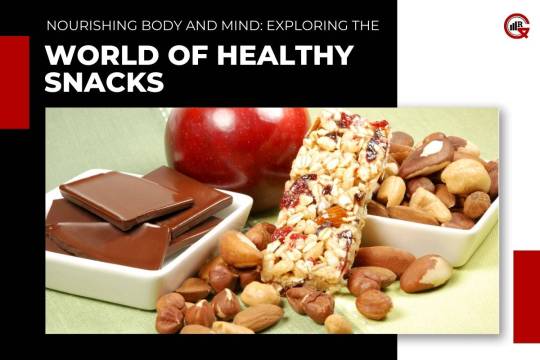
In today’s fast-paced world, maintaining a balanced diet can be challenging, especially when it comes to snacking. However, with a growing emphasis on health and wellness, the demand for nutritious and satisfying snacks has surged. Enter the realm of healthy snacks – delicious, convenient, and packed with essential nutrients to fuel our bodies and minds. In this article, we delve into the diverse landscape of healthy snacks, exploring their benefits, variety, and the role they play in supporting overall well-being.
The Rise of Healthy Snacking
Gone are the days when snacking was synonymous with empty calories and processed junk food. As consumers become more health-conscious and mindful of their dietary choices, the demand for healthier snack options has skyrocketed. According to market research, the global healthy snacks market is projected to continue its upward trajectory, driven by increasing awareness of the importance of nutrition, rising disposable incomes, and changing lifestyles.
Benefits of Healthy Snacks
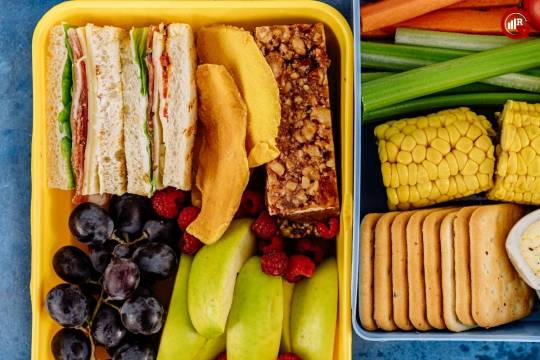
Healthy snacks offer a multitude of benefits beyond mere satiation. Here are some reasons why incorporating nutritious snacks into your diet is a smart choice:
Sustained Energy: Unlike sugary or high-carb snacks that lead to energy crashes, healthy snacks provide a steady source of energy to fuel your body throughout the day. Snacks rich in complex carbohydrates, fiber, and protein help stabilize blood sugar levels, keeping you feeling energized and focused.
Nutrient-Rich: Healthy snacks are packed with essential vitamins, minerals, antioxidants, and other nutrients that support overall health and well-being. Whether it’s vitamin-packed fruits and vegetables, protein-rich nuts and seeds, or fiber-filled whole grains, choosing nutrient-dense snacks helps nourish your body and promote optimal function.
Weight Management: Contrary to popular belief, snacking can aid in weight management when done mindfully. Healthy snacks can help curb cravings, prevent overeating at meal times, and keep hunger at bay, making it easier to maintain a healthy weight and avoid unhealthy food choices.
Improved Mood and Productivity: Nutrient-rich snacks have been linked to improved mood, cognitive function, and productivity. Foods rich in omega-3 fatty acids, such as nuts and seeds, and antioxidants, such as berries and dark chocolate, have been shown to support brain health and mental well-being, enhancing focus, concentration, and overall cognitive function.
Better Digestive Health: Many healthy snacks are rich in dietary fiber, which plays a crucial role in supporting digestive health and regularity. Fiber helps promote healthy digestion, prevent constipation, and maintain gut health by nourishing beneficial gut bacteria.
Variety of Healthy Snacks
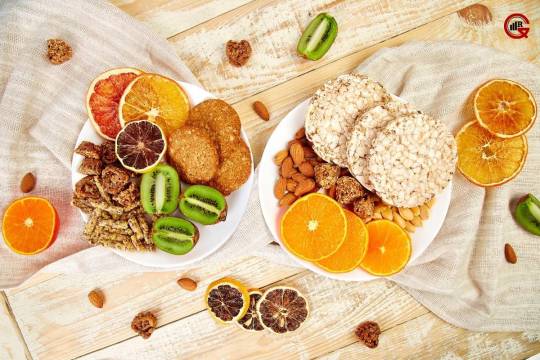
One of the best things about healthy snacking is the abundance of options available to suit every taste preference and dietary need. Here are some delicious and nutritious snack ideas to tantalize your taste buds:
Fresh Fruits and Vegetables: Nature’s original snack, fresh fruits and vegetables are bursting with vitamins, minerals, and fiber. From crunchy carrots and cucumber slices to juicy berries and citrus fruits, the possibilities are endless. Pair them with hummus, nut butter, or Greek yogurt for added protein and flavor.
Nuts and Seeds: Packed with heart-healthy fats, protein, and antioxidants, nuts and seeds make for satisfying and nutritious snacks. Almonds, walnuts, pumpkin seeds, and sunflower seeds are excellent choices. Enjoy them on their own or sprinkle them over yogurt, salads, or whole grain crackers for added crunch.
Greek Yogurt: Creamy, tangy, and rich in protein, Greek yogurt is a versatile snack option that can be enjoyed on its own or customized with your favorite toppings. Add fresh fruit, honey, granola, or nuts for a nutritious and delicious treat that satisfies sweet cravings while providing a protein boost.
Whole Grain Crackers and Rice Cakes: Choose whole grain crackers or rice cakes for a crunchy and satisfying snack that’s low in calories and high in fiber. Top them with avocado, cheese, tuna, or smoked salmon for a balanced snack that provides a mix of carbohydrates, protein, and healthy fats.
Homemade Trail Mix: Create your custom trail mix by combining nuts, seeds, dried fruits, and whole-grain cereal or pretzels. Customize the mix to suit your taste preferences and dietary needs, whether you prefer a sweet and salty combination or a savory blend with spices and herbs.
Smoothies and Smoothie Bowls: Whip up a nutrient-packed smoothie or smoothie bowl using a variety of fruits, vegetables, leafy greens, and protein sources such as Greek yogurt, protein powder, or nut butter. Blend until smooth and creamy, and enjoy as a refreshing and satisfying snack or meal replacement.
Snacking On-The-Go: Convenience Meets Nutrition

In today’s fast-paced world, convenience is key, and healthy snacking options are no exception. Here are some additional snack ideas that are perfect for busy lifestyles:
Protein Bars and Snack Packs: Protein bars and snack packs are convenient, portable options for satisfying hunger on the go. Look for bars made with whole food ingredients, such as nuts, seeds, and dried fruits, and minimal added sugars or artificial additives. These snacks provide a quick source of protein, fiber, and energy to keep you fueled between meals or during busy days.
Hard-Boiled Eggs: Hard-boiled eggs are a protein-packed snack that’s easy to prepare and transport. They’re rich in high-quality protein, vitamins, and minerals, making them a nutritious and satisfying option for snacking between meals. Pair them with whole grain crackers or sliced veggies for a balanced snack that keeps you feeling full and energized.
Vegetable Sticks and Dip: Cut-up vegetables, such as carrots, celery, bell peppers, and cucumbers, paired with hummus, guacamole, or Greek yogurt dip, make for a crunchy and satisfying snack that’s rich in fiber, vitamins, and antioxidants. Pack them in a small container or zip-top bag for an easy and nutritious snack to enjoy at work, school, or on the go.
Frozen Yogurt Bites: Freeze small portions of Greek yogurt with your favorite fruit, such as berries or sliced bananas, to create frozen yogurt bites that are perfect for snacking. These bite-sized treats are refreshing, creamy, and packed with protein and probiotics, making them a healthy alternative to traditional ice cream or frozen desserts.
Homemade Energy Balls: Make your energy balls using a combination of rolled oats, nut butter, honey, or maple syrup, and mix-ins such as dried fruits, nuts, seeds, or chocolate chips. Roll the mixture into bite-sized balls and refrigerate until firm. These homemade energy balls are a nutritious and delicious snack that’s perfect for satisfying sweet cravings and providing a quick energy boost.
Conclusion
In conclusion, healthy snacks are a delicious and convenient way to nourish your body and mind, providing essential nutrients to fuel your busy lifestyle. From fresh fruits and vegetables to nuts, seeds, yogurt, and whole grains, the options for nutritious snacks are endless. By choosing nutrient-dense snacks and incorporating them into your daily routine, you can support your overall health and well-being while satisfying cravings and staying energized throughout the day. So go ahead, and indulge in a delicious and nutritious snack – your body will thank you for it!
2 notes
·
View notes